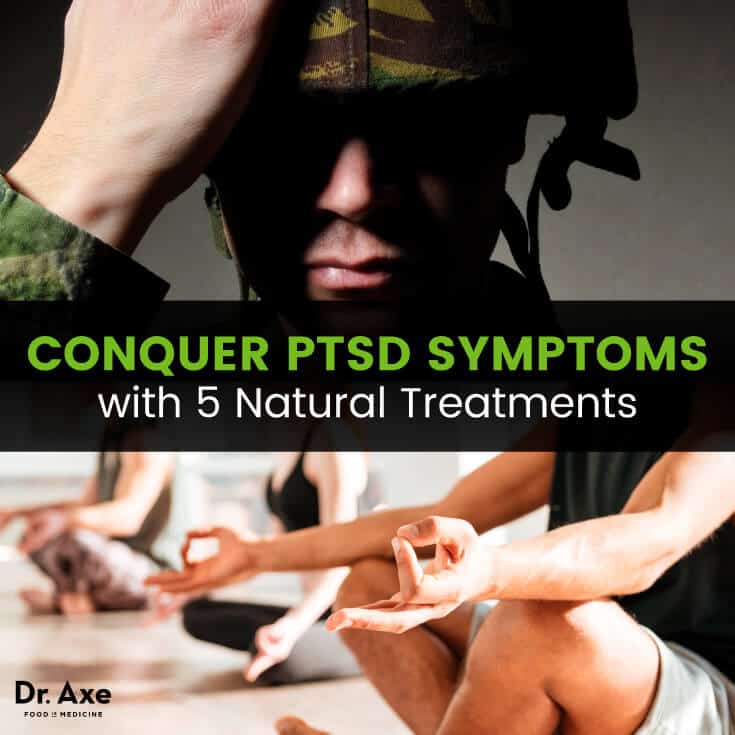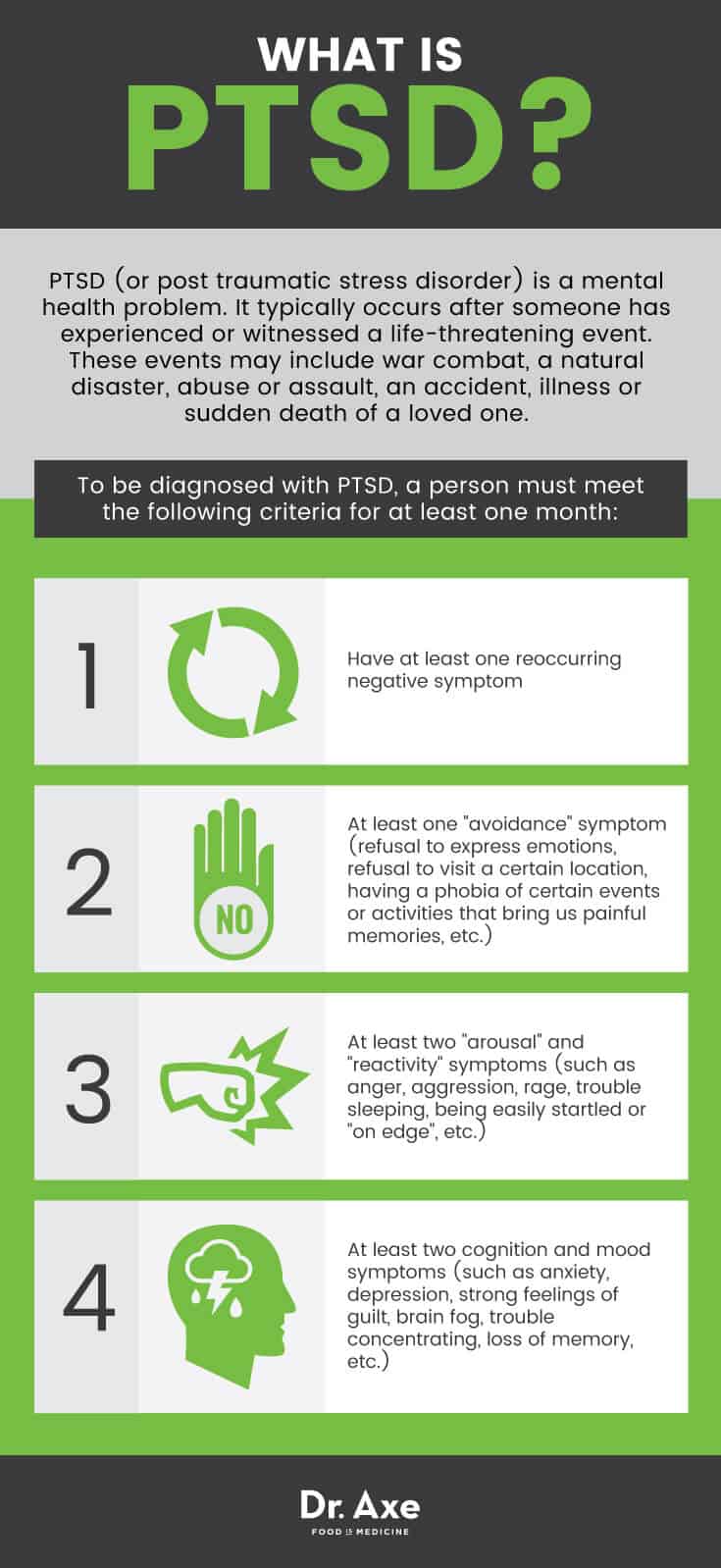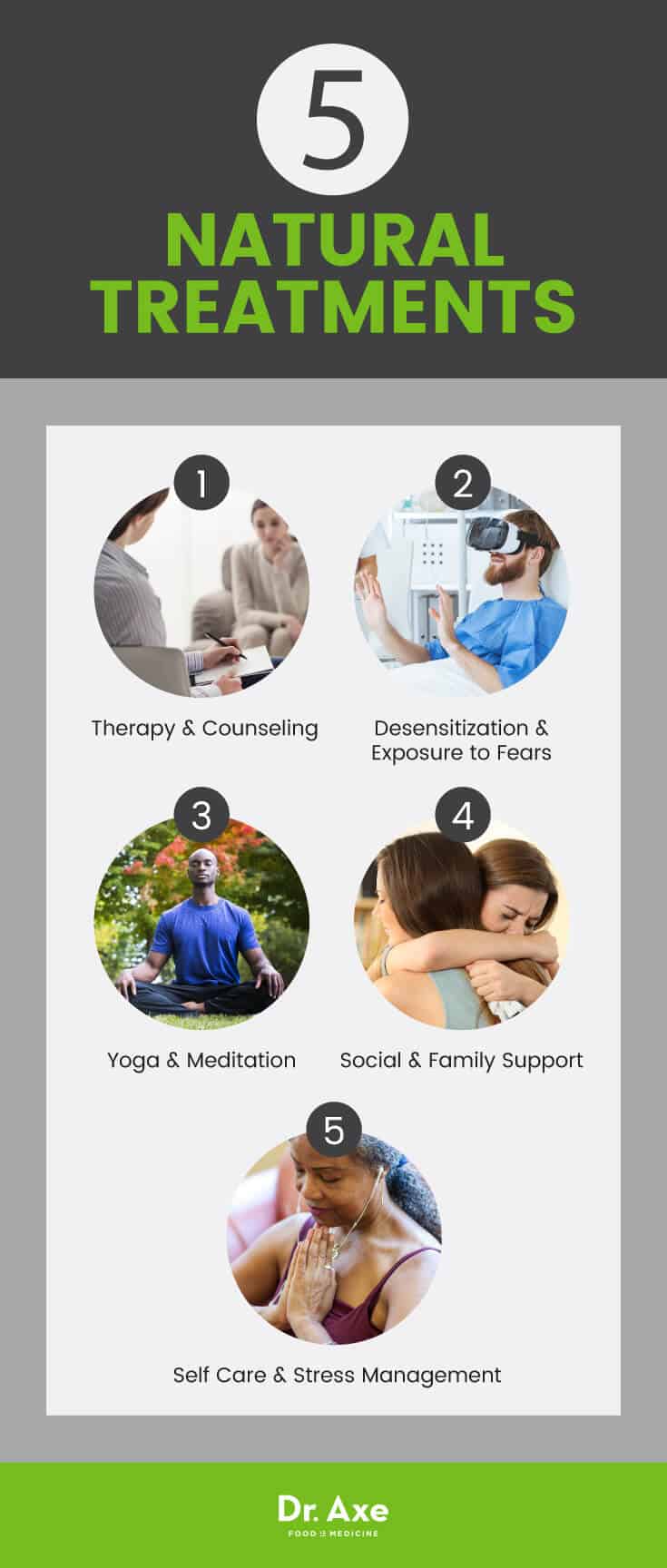
Sometimes trauma can haunt a person after experiencing one or more difficult and painful events, affecting their ability to live a normal, daily life. About 70 percent of adults in the U.S. will experience some type of traumatic event at some point in their lives, and among these people about 20 percent will go on to develop the condition called post traumatic stress disorder (or PTSD). (1)
The U.S Department of Veteran Affairs states that PTSD is a mental health problem that commonly occurs in veterans following combat. However, someone certainly doesn’t have to serve in the military to deal with symptoms of post traumatic stress. PTSD can affect both children and adults who have dealt with completely different types of traumatizing events. These events don’t necessarily have anything to do with war-time experiences or violence. Risk factors for suffering from PTSD include: surviving a natural disaster, getting into a car accident, dealing with another type of sudden illness or injury, and suffering from abuse, neglect, domestic violence or sexual assault. (2)
Psychiatrists and psychotherapists who treat patients with PTSD typically use a combination of approaches to help patients deal with symptoms like anxiety, insomnia, depression and social isolation. These can include medications (when needed), “talk therapy” or counseling, group support, and other natural outlets for negative emotions, like exercise or meditation.
What is PTSD?
The definition of post traumatic stress disorder (PTSD) is “a psychiatric disorder that occurs following the experience or witnessing of a life-threatening event.” (3)
PTSD (or post traumatic stress disorder) is a mental health problem. It typically occurs after someone has experienced or witnessed a life-threatening event. These events may include war combat, a natural disaster, abuse or assault, an accident, illness or sudden death of a loved one.
To be diagnosed with PTSD, a person must meet the following criteria for at least one month:
- Have at least one reoccurring negative symptom
- At least one “avoidance” symptom (refusal to express emotions, refusal to visit a certain location, having a phobia of certain events or activities that bring us painful memories, etc.)
- At least two “arousal” and “reactivity” symptoms (such as anger, aggression, rage, trouble sleeping, being easily startled or “on edge”, etc.)
- At least two cognition and mood symptoms (such as anxiety, depression, strong feelings of guilt, brain fog, trouble concentrating, loss of memory, etc.)
Common PTSD Symptoms & Warning Signs
Any time you experience something that is very threatening, scary, shocking or deeply upsetting, it’s normal to deal with uncomfortable emotions and sometimes to even display maladaptive behaviors. Most people experience at least some type of trauma at some point in their lives. But the majority do not deal with PTSD as a result. People who have “normal” coping mechanisms usually recover naturally from initial symptoms due to shock or sadness within a short time period.
What makes PTSD symptoms different from negative emotions that are considered normal aspects of grief or healing?
In those who don’t have PTSD, an upsetting or dangerous event can cause serious symptoms. But the symptoms usually go away after a few weeks (this is called acute stress disorder, or ASD). On the contrary, long after the dangerous or upsetting event is over, people experiencing post-traumatic stress will still feel very anxious, unable to express themselves, and in general “not themselves.” PTSD symptoms usually begin shortly after the event takes place. Typically symptoms start within three months and last for up to a year. However, sometimes abnormal symptoms might not appear for up to several years after the event has ended. This delay can sometimes make seeking help and getting a proper diagnosis a complicated issue.
In order to be diagnosed with PTSD, a patient’s symptoms must:
- Meet the criteria described above
- Last more than one month
- Be severe enough to interfere with relationships or work
- According to experts, PTSD is often (but not always) accompanied by changes in mood. These changes may include depression, anxiety, social isolation and substance abuse.
According to the Anxiety and Depression Association of America, some of the most common symptoms of PTSD include: (4)
- Having flashbacks (reliving the trauma via memories and bodily sensations over and over again)
- Physical symptoms of anxiety including a racing heart, sweating, inability to think clearly, etc.
- Nightmares or strange dreams, insomnia, and difficulty getting enough rest
- Having frightening thoughts that appear to come out of nowhere and last for several hours
- Feeling very anxious when encountering images, words, objects or situations that are reminders of the traumatic event
- Avoiding talking to anybody else about thoughts or feelings related to the traumatic event
- Refusal to do certain things, or making changes in one’s personal routine, in order to avoid scary triggers or memories (this can include driving, going on vacation, being in an intimate relationship, etc.)
- Being tense, on edge and easily startled
- Having angry outbursts and sometimes being violent or aggressive with family and strangers
- Sometimes difficulty having a normal job, completing tasks due to lack of concentration, learning and remembering new or old information
- Other symptoms tied to high stress levels, such as changes in appetite or weight, headaches, digestive issues and skin irritation
- Higher risk for substance abuse (including medications, drugs or alcohol)
- Depression (ongoing negative thoughts about oneself or the world), distorted feelings of guilt or blame, social isolation due to feeling alienated or misunderstood, loss of interest in enjoyable activities or hobbies due to low motivation, and in severe cases suicidal thoughts
- Children suffering from PTSD can also deal with symptoms like inability to open up to others or connect, trouble sleeping, difficulty learning, bed-wetting, or acting very “clingy” with caregivers. Teens can sometimes cause problems in school, be disrespectful to teachers or authority figures, be aggressive and violent.
How long do PTSD symptoms last? Every person has a different experience; some overcome their symptoms and reach a stage considered to be “recovery” within about six months. Others deal with symptoms for years. Getting professional help from a therapist, seeking support from a group of peers or family and friends, and sometimes considering medication can all decrease the odds that PTSD will remain chronic and debilitating for many years.

PTSD Causes and Risk Factors
Researchers, including neuroscientists (who study the brain) and psychotherapists (who study maladaptive behaviors), have found that people with PTSD display abnormal levels of certain stress hormones, in addition to experiencing changes in brain activity.
- Adrenaline, the hormone that helps kickstart the “fight or flight response” in response to danger, has been shown to remain elevated in people with PTSD long after the event has ended. This reaction is different than what occurs in people without PTSD.
- Under normal circumstances, when someone without PTSD becomes scared or feels in danger, as soon as the threat is over their stress hormones dissipate and their body returns back to normal (homeostasis). However, in traumatized people this decline takes much longer.
- The perception of danger or fear triggers many split-second changes in the body and brain, evoking the fight-or-flight response. For example, scary or unusual situations can cause our heart rate to speed up, breathing to get faster, the pupils in our eyes to dilate, perspiration to increase and digestion to slow down. These reactions are the body’s natural way of handling threatening situations by preparing us to defend ourselves, or to run away and thereby avoid the problem or predator.
- These physiological symptoms tied to stress will continue for many months, even years, in people experiencing PTSD. Stress hormones will also spike very quickly and disproportionately in response to even mildly stressful stimuli. Constantly elevated stress hormones negatively impact the entire body, including memory, emotion regulation and attention. The result is high levels of irritability, muscle tension, sleep disorders, heart problems, and many other long-term health issues.
Other neurological and biochemical changes have also been shown to take place in the brains and bodies of those with PTSD, including in the limbic system (the primal, emotional center of the brain). Studies suggest that three of the primary areas impacted by trauma include:
- Amygdala
- Hippocampus
- Pre-frontal cortex (PFC)
Changes in the brain following traumatic events can even be similar to the types of neurological changes seen in patients with brain injuries due to impact, accidents, etc. (5) According to Dr. Bessel van der Kolk, psychotherapist and author of “The Body Keeps the Score: Brain, Mind, and Body in the Healing of Trauma,” MRI brain scans clearly show that images of past trauma activate the right hemisphere of the brain and deactivate the left. The two halves of the brain do “speak different languages” so to speak. The right is considered more intuitive, emotional, visual, spatial and tactual. The left is linguistic, sequential and analytical. The right brain is also the first to develop in the womb. It’s responsible for nonverbal communication between mothers and infants. The left brain remembers facts, statistics and the vocabulary of events.
Dr. Kolk states that “We call on the left side to explain our experiences and put them in order. The right brain stores memories of sound, touch, smell, and the emotions they evoke. Under ordinary circumstances the two sides of the brain work together more or less smoothly….However, having one side or the other shut down, even temporarily, or having one side cut off entirely (as sometimes happens in brain surgery) is disabling.”
Changes in brain activity, including deactivation of the left hemisphere, directly impact the capacity to organize past experiences, put them into logical sequences, and to translate shifting feelings and perceptions into words that can be expressed to others. Essentially PTSD occurs due to loss of normal “executive functioning.” In other words, it occurs due to a loss of the ability to identify cause and effect, grasp the long-term effects of behaviors or actions, and create plans for the future.
Risk Factors for Post Traumatic Stress Disorder:
As mentioned earlier, those who are more likely to struggle with PTSD include: (6)
- War veterans
- Children and adults who have been through physical or sexual assault
- Those who have dealt with any type of abuse, accidents, natural disasters, terrorist attacks, political violence, death of a loved one, a serious illness or injury, or many other types of traumatizing events that seem “out of their control”
- A history of substance abuse or using drugs
- Women are more likely to develop PTSD than men, although it’s not exactly clear why. A high risk factor for women is having a history of sexual assault and rape
- Genetics also seem to be play a role in mental illnesses, including anxiety, depression and PTSD. A family history of mental illness can make some people more likely to develop PTSD than others, especially when combined with other risk factors (7)
Conventional Treatment for Post Traumatic Stress Disorder
- The most studied type of treatment for PTSD is use of prescription medications, especially antidepressants. Most experts believe that medications work best when combined with psychotherapy in order to help the patient to feel more in control of their recovery.
- Drugs intended for PTSD are used to help patients deal with feelings of anxiety, sadness, anger, lack of motivation, feeling numb inside, social isolation, etc.
- Antidepressants for PTSD include several types of SSRIs (selective serotonin reuptake inhibitors) and SNRIs (serotonin-norepinephrine reuptake inhibitors). These are used to treat depression in general, including in patients who do not have PTSD but suffer from similar symptoms. One medication called Prazosin is commonly prescribed for PTSD symptoms tied to anxiety and depression, including physical reactions, nightmares and helplessness.
- While side effects are always possible when using medications, they can also be life-saving for some patients. They can also be an important catalyst towards recovery while also beginning other natural treatments. Medications will not work for every patient. There are no guarantees and a wide array of reactions depending on the specific drug.

5 Natural Treatments for PTSD
1. Therapy & Counseling
Various types of psychotherapy (talk therapy) are used to help people overcome PTSD. The type of therapy depends on their situation and access to professional care. Although many patients report experiencing increased distress during initial therapy sessions, as they get accustomed to discussing traumatic memories, one study found that talking about trauma in therapy sessions resulted in 86 percent of participants showing improvement in their PTSD and psychotic symptoms by the end of treatment. (8) One type that has been shown to be very effective is cognitive behavioral therapy (CBT) in which thoughts are examined in order to determine how they affect behaviors and self-perception.
Some of the primary goals of therapy for PTSD include:
- Training a patient to better access their “emotional brain” that has been cut off. Many with PTSD feel “numb” and cannot tie events to emotions. A therapist can help the person open up about how they’re really feeling and form connections.
- Increasing self awareness. A therapist can teach a patient skills to understand how trauma changed their thoughts and feelings, in addition to how it impacts their body and health.
- Regaining a feeling of having control over one’s own life.
- And helping to develop coping strategies for dealing with difficult emotions.
Therapists often work with patients with PTSD to help them learn to become more aware of their inner experience and to begin to befriend what is going on inside themselves. This includes physical sensations, emotions and thoughts. Learning from past experiences and better vocalizing of feelings are other important areas to address. This is because helplessness and social withdrawal are both very common with PTSD.
2. Desensitization & Exposure to Fears
In addition to common types of talk therapy, several forms of exposure therapy are also used to desensitize patients to perceived threats, relieve stress and help them to face fears directly. A professional therapist usually conducts exposure therapy. The therapist can be a guide as the patient gradually faces situations, objects or locations that bring up strong feelings of the traumatic event.
- Prolonged Exposure (PE) — This is a type of therapy that involves discussing, facing and recalling the traumatic event in detail in order to gain control over upsetting thoughts, physical reactions and feelings about the trauma. The idea is that the more someone discusses the upsetting event, the more familiar it becomes and therefore the less feared. There are different ways to expose the patient to their fears. These include using imagining, writing, drawing or painting, or visiting the place where the event happened.
- Cognitive restructuring — This approach is similar to CBT and other forms of exposure therapy. It helps people make sense of the bad memories by discussing them. Feelings of regret, guilt and shame are often a central component to talk about since they can contribute to the patient feeling “stuck.”
- Eye Movement Desensitization and Reprocessing (EMDR) — This involves having the patient focus their attention on physical movement or sensations (like breath, sounds or hand movements) while they recall the trauma and talk about it openly. By doing this, they have something to ground their attention in order to help their brain work through the traumatic memories.
3. Yoga & Meditation
In research supported by the National Institutes of Health, patients that took part in a ten-week program including yoga and mind-body practices on average experienced markedly reduced PTSD symptoms, even patients who had failed to respond to any previously used medications. (9) Yoga has been shown to change the brain by helping to increase “happy” neurotransmitters, reducing the effects of stress, helping to improve coping mechanisms for negative feelings, and more. Participants in the study learned ways to help increase five specific types of positive, comforting feelings. These feelings are: gratitude and compassion, relatedness, acceptance, centeredness and empowerment (GRACE).
Research suggests that another reason that yoga and other forms of mind-body practices work so well for reducing PTSD symptoms is because they positively impact the nervous system. This is because they can change chemical signals sent via the vagus nerve back to the brain. The vagus nerve is a large bundle of fibers that connects the brain with many internal organs. Researchers believe that about 80 percent of the fibers that make up the vagus nerve run from the body into the brain. Studies have found that we can directly influence the type of hormonal and chemical signals sent from the body to the brain. This means signaling to the brain if we should feel aroused versus relaxed depending on how we manipulate our body.
Some of the ways that PTSD patients can directly tap into their body’s “relaxation response” include: controlled breathing, stretching or moving in purposeful ways (i.e. yoga asanas), chanting songs or mantras with a group, and practicing dozens of styles of meditation. These methods have been utilized to help people deal with stress for thousands of years, dating back to the origins of Traditional Chinese Medicine, many religious practices, and yoga.
There is also lots of emerging data supporting mindfulness and meditation as an effective treatment approach for patients with PTSD, due to how “neuroplasticity” (the brain’s ability to change itself based on repetition and focused attention) can improve neurological processes and brain structures, reduce activity of the amygdala (the fear center of the brain), help with emotion regulation, and improve integration of the right and left hemispheres of the brain. (10)
Changes in Brain Structure:
Deregulation of the brain areas associated with emotional regulation and memory is a key contributor to the symptoms associated with PTSD. This is in addition to the overactivity of the fear center, the amygdala. Mindfulness reverses these patterns by increasing prefrontal and hippocampal activity, and toning down the amygdala.
4. Social & Family Support
One of the strongest predictors of being able to overcome PTSD is “building resilience” through social support and close relationships. Certain factors can help increase resilience that reduces the risk for long-term symptoms tied to stress, including:
- Joining a support group, which helps to decrease feelings of isolation and alienation by opening up to others and forming compassionate relationships
- Visiting a family therapist in order to increase support from family, spouses, children or close friends
- Finding a spiritual or faith-based support group that can offer encouragement, an outlet, hope and positive feedback
- Social support also helps to reduce aggression. It teaches those with PTSD how to respond to fear or other negative feelings without shutting others out. It also can give life a sense of purpose or meaning.
5. Self Care & Stress Management
In addition to getting support from others, self-care is crucial for managing stress and triggers. Experts recommend some of these strategies for reducing anxiety and sources of stress in your life:
- Engaging in regular, but usually mild, physical activity or exercise
- Getting enough sleep and down time
- Being patient, including having realistic goals for how long it can take to feel better
- Reducing work-related stress and not taking on too much at once
- Spending more time in nature and with other people who help you feel comforted
- Becoming more knowledgeable about the condition through reading, journaling, speaking with a professional, videos, podcasts, etc.
Precautions Regarding Treatment for PTSD
If you suspect that you or someone you know is suffering from PTSD, it’s best to reach out for help right away in order to start the road to recovery. When feelings become unbearable and interfere with normal life, ask a family member, teacher or your doctor for help. You can refer to the National Institute of Mental Health’s Help for Mental Illnesses page to find a qualified mental health provider or social services worker in your area. In the case of an emergency (such as during a period of panic or major depression) an emergency room doctor can also provide temporary help.
Final Thoughts on PTSD Symptoms & Treatment
- PTSD (or post traumatic stress disorder) is a mental health problem. It affects about seven to eight percent of the population, including children and teens. It typically occurs after someone has experienced or witnessed a life-threatening event. These events may include war combat, a natural disaster, abuse or assault, an accident, illness or sudden death of a loved one.
- Symptoms of PTSD include anxiety, depression, social isolation, sleep trouble and nightmares, aggression, avoiding talking to anybody else about thoughts or feelings related to the traumatic event, and refusal to do certain things tied to the trauma due to fear.
- Treatments for PTSD include use of medications, therapy or counseling, group and family support, yoga, exercise, meditation and other forms of managing stress through self-care.
Read Next: St. John’s Wort Uses: Relieve Depression, PMS & Menopause Symptoms
If you feel like you could use some more in depth information on essential oils, Dr. Josh Axe is hosting a free webinar going over, in great detail, uses and tips for using essential oils. Click below to learn more.
